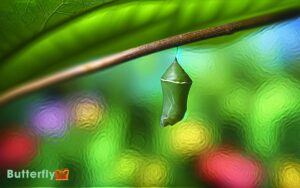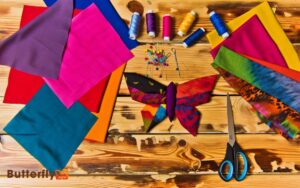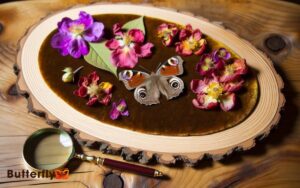Guide: Do Morpho Butterflies Eat What?
Morpho butterflies exhibit distinct dietary preferences across their life stages. As caterpillars, they mainly consume leaves from the Fabaceae and Arecaceae families, favoring young, nutrient-rich leaves from Erythrina and Machaerium species.
This diet provides essential proteins, carbohydrates, and lipids. Adult Morphos shift to a liquid diet, utilizing their proboscis to consume fermenting fruits, tree sap, and decomposing organic matter, which supply crucial sugars and minerals necessary for energy and metabolic functions.
This dietary shift influences their ecological interactions and reproductive success. To gain deeper insights into these fascinating dietary habits, exploring further details can be illuminating.
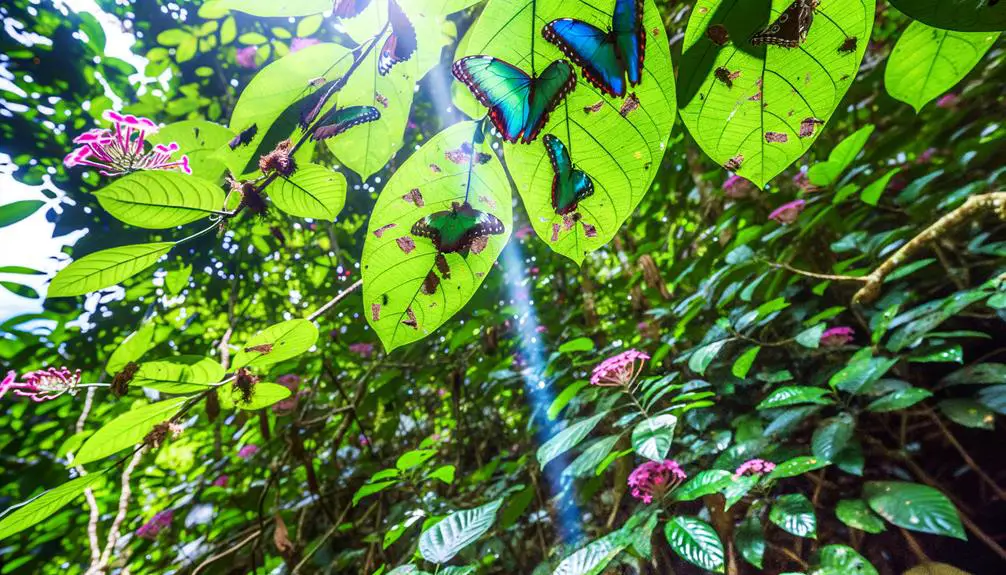
Key Takeaways
- Adult Morpho butterflies primarily consume fermenting fruits, tree sap, and decomposing organic matter.
- Caterpillar stage Morpho butterflies feed on leaves from the Fabaceae and Arecaceae families.
- Nectar from flowers provides essential sugars, amino acids, and vitamins for adult Morpho butterflies.
- Seasonal diet changes include fermenting fruits in the wet season and tree sap, fungi, and decaying matter in the dry season.
Caterpillar Stage Diet
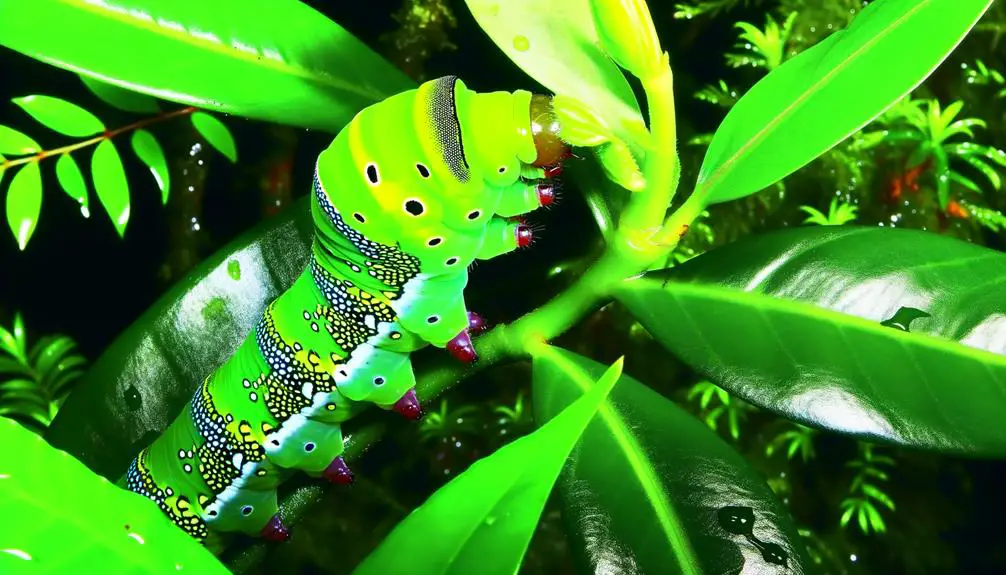
During the caterpillar stage, Morpho butterflies primarily consume the leaves of various host plants, including species within the Fabaceae and Arecaceae families.
This herbivorous diet is essential for their growth and development, providing vital nutrients such as proteins, carbohydrates, and lipids.
The caterpillars exhibit specific feeding behaviors, often selecting young, tender leaves that are easier to digest and richer in nutrients.
Their mandibles are specially adapted to chew plant material, efficiently breaking down the cellular structure of the leaves.
Additionally, their digestive system is well-equipped to process the ingested plant matter, facilitating the conversion of consumed foliage into energy and biomass.
This stage is pivotal, as adequate nutrition directly impacts their metamorphosis into healthy, vibrant adult butterflies.
Leaf Preferences
Morpho butterfly caterpillars exhibit a marked preference for the tender, nutrient-rich leaves of specific host plants, which optimizes their nutritional intake and supports their rapid growth and development.
These larvae primarily feed on the foliage of Fabaceae family members, such as Erythrina and Machaerium species. The selection of these plants is not arbitrary; their leaves are replete with essential amino acids, vitamins, and minerals that cater to the caterpillars' metabolic needs.
The high moisture content in these leaves also aids in hydration, reducing the larvae's dependency on external water sources.
This specialized feeding behavior not only maximizes their survival rates but also facilitates efficient energy conversion necessary for the subsequent metamorphic stages.
Adult Butterfly Diet

Upon reaching adulthood, the feeding habits of Morpho butterflies undergo a significant shift from their larval stage, focusing primarily on a diet of fermenting fruit, tree sap, and decomposing organic matter.
This change is essential as adult Morphos rely on a liquid diet, facilitated by their proboscis, a specialized feeding tube.
The fermenting fruits provide important sugars and carbohydrates necessary for energy, while tree sap offers essential nutrients and minerals.
Decomposing organic matter, including rotting plant material, supplements their intake of amino acids and other organic compounds.
This dietary shift not only supports their metabolic needs but also plays a role in their ecological interactions, influencing their behavior, longevity, and reproductive success within their tropical habitats.
Fermenting Fruits
Fermenting fruits constitute a primary dietary component for adult Morpho butterflies, providing them with a rich source of sugars and carbohydrates essential for their energy requirements.
These fruits, in various stages of decomposition, undergo fermentation processes that break down complex carbohydrates into simpler sugars, making them readily absorbable.
The fermentation also produces alcohol, which can be beneficial for the butterflies by acting as an antimicrobial agent, thereby reducing the risk of infections. Additionally, the presence of alcohol in their diet may influence butterfly behavior, potentially affecting their feeding or mating habits. This raises interesting questions, such as what sound does a butterfly make when experiencing the effects of fermented food sources, even though butterflies are generally silent creatures. Further research could explore how these natural compounds impact their overall health and survival in the wild.
Morphos utilize their proboscis to extract these nutrient-rich liquids, enabling sustained flight and reproductive activities.
The high sugar content aids in maintaining metabolic functions, vital for their survival in the wild.
This reliance on fermenting fruits underscores the butterflies' adaptability in exploiting available resources in their habitats.
Nectar Sources

Drawing nectar from flowers represents another significant dietary strategy for Morpho butterflies, facilitating the intake of essential nutrients such as sugars, amino acids, and vitamins.
This nectar provides a rapid source of energy, vital for sustaining their vibrant flight patterns and overall metabolic functions.
Morpho butterflies exhibit a preference for specific flowering plants, often selecting species with high nectar concentrations.
Their proboscis, a specialized feeding organ, allows efficient extraction of nectar from deep within floral structures.
Remarkably, the butterflies' interaction with these plants also supports pollination, contributing to ecosystem health.
The reliance on various nectar sources underscores the ecological adaptability and nutritional strategies that Morpho butterflies employ to thrive in their natural habitats.
Feeding Behavior
Examining the feeding behavior of Morpho butterflies reveals intricate patterns that confirm efficient nutrient acquisition from both nectar sources and other dietary elements in their environment.
These butterflies utilize their proboscis to extract nectar from flowers, a behavior characteristic of many Lepidoptera. However, Morpho butterflies also consume rotting fruit, tree sap, and decomposing animal matter, diversifying their nutrient intake.
Their feeding activity typically occurs during the warmer parts of the day when nectar production is highest. Additionally, Morpho butterflies exhibit sunning behavior, which aids in thermoregulation, optimizing their physiological functions for feeding.
This multifaceted approach to feeding ensures they meet their metabolic needs, supporting their vibrant coloration and sustained flight capabilities.
Seasonal Diet Changes
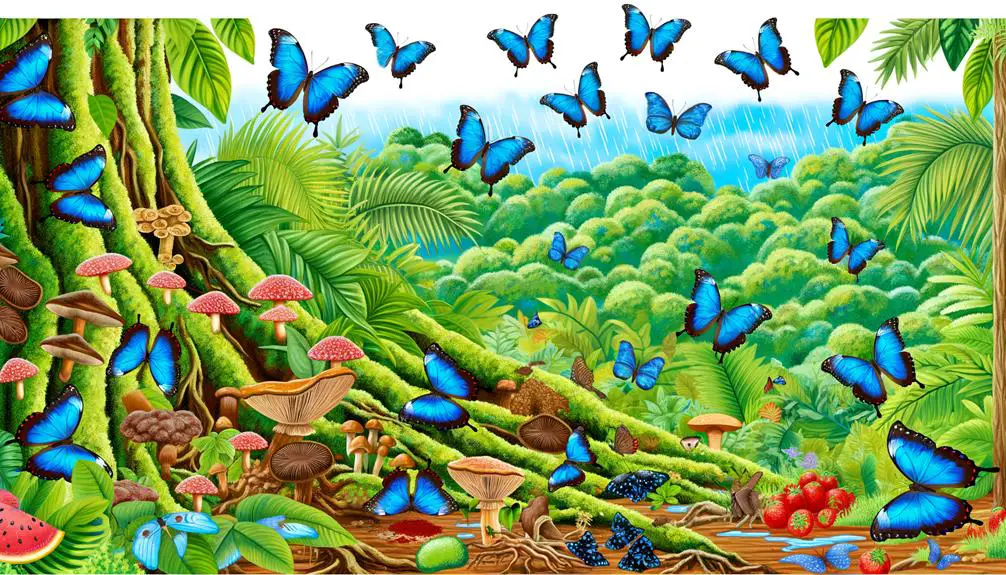
Seasonal variations considerably influence the dietary preferences of Morpho butterflies, as changes in temperature and resource availability dictate the types of food they consume.
During the wet season, Morpho butterflies mainly feed on fermenting fruits, which are more plentiful due to increased precipitation. The abundance of overripe fruits provides essential sugars necessary for energy.
Conversely, in the dry season, when fruit is scarce, these butterflies adjust their diet to include alternative sources such as tree sap, fungi, and decaying plant matter. This dietary flexibility guarantees their survival across varying environmental conditions.
Additionally, seasonal shifts may also affect the nutritional content of available food, thereby influencing the feeding behavior and physiological needs of Morpho butterflies.
Conclusion
In summary, the dietary habits of Morpho butterflies exhibit remarkable adaptations throughout their life stages.
During the caterpillar stage, they primarily consume leaves, with distinct preferences for certain plant species.
Adult Morphos shift to feeding on fermenting fruits and occasional nectar sources.
An intriguing statistic reveals that Morpho butterflies can detect fruit fermentation from over 100 meters away, showcasing their acute sensory capabilities.
These dietary behaviors underscore the complex ecological interactions and evolutionary strategies of Morpho butterflies.


